 W
WAculepeira packardi is a species of orb weaver in the spider family Araneidae. It is found in North America, Russia, China, and Kazakhstan.
 W
WAphonopelma steindachneri is a species of spider in the family Theraphosidae, found in United States (California) and Mexico.
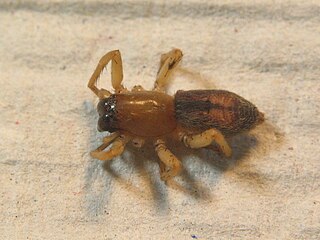 W
WClubiona subsultans, the Caledonian sac spider, is a spider from the family Clubionidae with a Palearctic distribution.
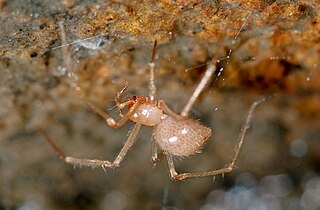 W
WEidmannella pallida is a species of true spider in the family Nesticidae. It is found in North America, has been introduced into Pacific Islands, Galapagos Islands, Macaronesia, Spain, and Japan.
 W
WHemicloea rogenhoferi, also known as the flattened bark spider, is a species of spider belonging to the family Gnaphosidae. The spider is endemic to the east coast of Australia. It is also naturalised in New Zealand where it has established at sites throughout the North Island and South Island.
 W
WHeteropoda cervina, commonly called the brown huntsman, is a large species of spider in the family Sparassidae often found in leaf litter in central Queensland, Australia. The species was first described by Ludwig Carl Christian Koch in 1875 as Sarotes cervinus.
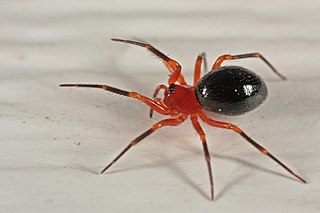 W
WHypselistes florens is a species of dwarf spider in the family Linyphiidae. It is found in the United States and Canada.
 W
WIschnothele caudata is a spider in the family Ischnothelidae, found from Mexico to Brazil. It was first described in 1875 by Anton Ausserer. Ausserer did not explain the choice of specific name, but the Latin word caudatus means 'tailed'.
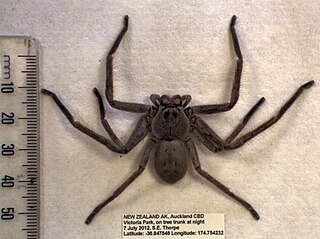 W
WIsopeda villosa is a species of huntsman spider native to New South Wales, Australia, and possibly established in Auckland, New Zealand. It was first described by Ludwig Carl Christian Koch in 1875.
 W
WMegaphobema robustum, known as the Colombian giant tarantula or Colombian giant redleg, has a span of 6 to 8 inches. Found in the tropical rainforests of Colombia and Brazil near logs, it will eat crickets, other large insects, small lizards and various mice. It is known for its defensive behavior.
 W
WNeoscona nautica, the brown sailor spider, is a species of orb weaver in the family Araneidae. It is found in Asia and Pacific islands, has been introduced into both Americas, and Sudan.
 W
WOvtsharenkoia is a monotypic genus of Asian tree trunk spiders containing the single species, Ovtsharenkoia pallida. It was first described by Yuri M. Marusik & Victor R. Fet in 2009, and has only been found in Central Asia.
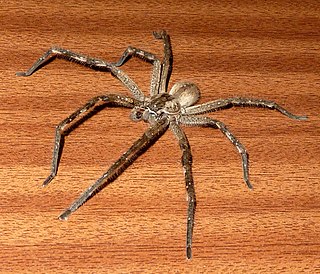 W
WThe common rain spider, formerly P. natalius, is a species of huntsman spider native to Southern Africa. It is the most common and widespread species in the genus Palystes. Its distribution ranges from KwaZulu-Natal province in the east, then westwards to the provinces of Mpumalanga, Limpopo, Gauteng and North West in the north, and Eastern Cape and Western Cape in the south. It has a body length of 15–36 mm and a leg span of up to 110mm. The species was first described by Ludwig Carl Christian Koch in 1875.
 W
WPamphobeteus nigricolor is a large species of tarantula found in Colombia and Brazil. First described in 1875 by Anton Ausserer as Lasiodora nigricolor, in 1901 Reginald Innes Pocock moved it to the new genus Pamphobeteus, and designated it as the genus's type species.
 W
WPandercetes gracilis, also called the lichen huntsman spider and the lichen spider, is a huntsman spider found on New Guinea, the Maluku Islands, Sulawesi, and in Queensland, Australia. Individuals can vary in color and many color forms exist, but unlike squids and certain reptiles, color is fixed at its previous molt. It hunts by hiding among moss and lichen, then ambushing prey that comes into range by pouncing on it.
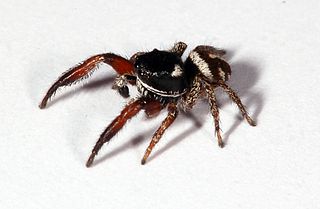 W
WPellenes nigrociliatus is a jumping spider species in the genus Pellenes.
 W
WPellenes seriatus is a species of 'jumping spiders' belonging to the family Salticidae.
 W
WSteatoda nobilis is a spider in the genus Steatoda, known in the United Kingdom as the noble false widow and often referred to as the false widow. As the common name indicates, the spider superficially resembles and is frequently confused for the black widow and other spiders in the genus Latrodectus, which can have medically significant venom. Steatoda nobilis is native to Madeira and the Canary Islands from where it allegedly spread to Europe, and arrived in England before 1879, perhaps through cargo sent to Torquay. In England it has a reputation as one of the few local spider species which is capable of inflicting a painful bite to humans, with most bites resulting in symptoms similar to a bee or wasp sting. It has also been found in California and Chile.
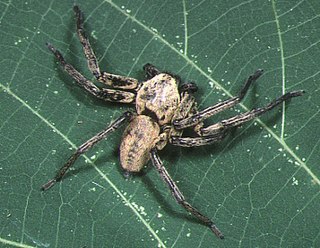 W
WThelcticopis severa is a species of huntsman spider found in China, Laos, Korea, and Japan. It is the type species for the genus Thelcticopis, and was first described by Charles Athanase Walckenaer in 1875.
 W
WTibellus macellus is a spider found from Europe to Central Asia.
 W
WTliltocatl vagans is a species of tarantula known commonly as the Mexican red rump. It ranges predominantly in Mexico, but is also found in Central America. They are terrestrial, burrowing spiders. The reason for the name red rump is because of its distinctive red hairs on its abdomen. Like most tarantulas, they will eat anything they can overpower, which is usually insects, but small lizards and rodents may also be consumed. They can grow up to a solid 6.5 inch leg span, with males typically being smaller and thinner than the females. They prefer shrubland habitats.